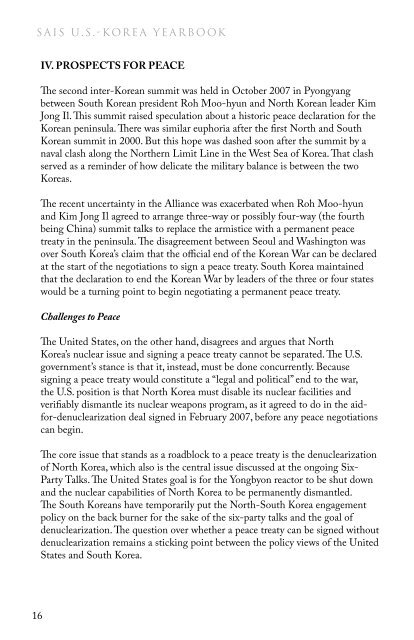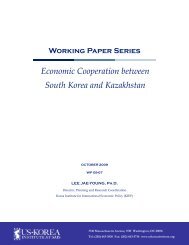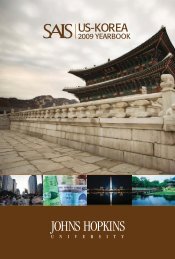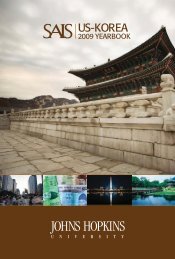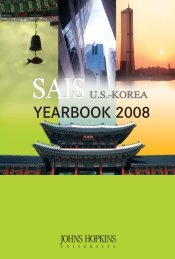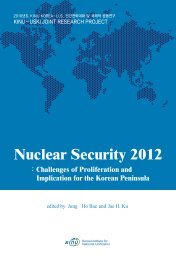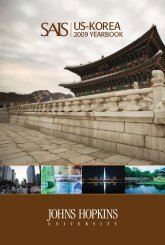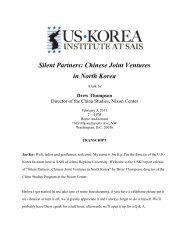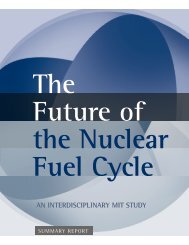YeArBooK 2007 - US-Korea Institute at SAIS
YeArBooK 2007 - US-Korea Institute at SAIS
YeArBooK 2007 - US-Korea Institute at SAIS
Create successful ePaper yourself
Turn your PDF publications into a flip-book with our unique Google optimized e-Paper software.
saIs U.s.-<strong>Korea</strong> YearbooK<br />
16<br />
IV. ProSPeCTS for PeACe<br />
The second inter-<strong>Korea</strong>n summit was held in October <strong>2007</strong> in Pyongyang<br />
between South <strong>Korea</strong>n president Roh Moo-hyun and North <strong>Korea</strong>n leader Kim<br />
Jong Il. This summit raised specul<strong>at</strong>ion about a historic peace declar<strong>at</strong>ion for the<br />
<strong>Korea</strong>n peninsula. There was similar euphoria after the first North and South<br />
<strong>Korea</strong>n summit in 2000. But this hope was dashed soon after the summit by a<br />
naval clash along the Northern Limit Line in the West Sea of <strong>Korea</strong>. Th<strong>at</strong> clash<br />
served as a reminder of how delic<strong>at</strong>e the military balance is between the two<br />
<strong>Korea</strong>s.<br />
The recent uncertainty in the Alliance was exacerb<strong>at</strong>ed when Roh Moo-hyun<br />
and Kim Jong Il agreed to arrange three-way or possibly four-way (the fourth<br />
being China) summit talks to replace the armistice with a permanent peace<br />
tre<strong>at</strong>y in the peninsula. The disagreement between Seoul and Washington was<br />
over South <strong>Korea</strong>’s claim th<strong>at</strong> the official end of the <strong>Korea</strong>n War can be declared<br />
<strong>at</strong> the start of the negoti<strong>at</strong>ions to sign a peace tre<strong>at</strong>y. South <strong>Korea</strong> maintained<br />
th<strong>at</strong> the declar<strong>at</strong>ion to end the <strong>Korea</strong>n War by leaders of the three or four st<strong>at</strong>es<br />
would be a turning point to begin negoti<strong>at</strong>ing a permanent peace tre<strong>at</strong>y.<br />
Challenges to Peace<br />
The United St<strong>at</strong>es, on the other hand, disagrees and argues th<strong>at</strong> North<br />
<strong>Korea</strong>’s nuclear issue and signing a peace tre<strong>at</strong>y cannot be separ<strong>at</strong>ed. The U.S.<br />
government’s stance is th<strong>at</strong> it, instead, must be done concurrently. Because<br />
signing a peace tre<strong>at</strong>y would constitute a “legal and political” end to the war,<br />
the U.S. position is th<strong>at</strong> North <strong>Korea</strong> must disable its nuclear facilities and<br />
verifiably dismantle its nuclear weapons program, as it agreed to do in the aidfor-denucleariz<strong>at</strong>ion<br />
deal signed in February <strong>2007</strong>, before any peace negoti<strong>at</strong>ions<br />
can begin.<br />
The core issue th<strong>at</strong> stands as a roadblock to a peace tre<strong>at</strong>y is the denucleariz<strong>at</strong>ion<br />
of North <strong>Korea</strong>, which also is the central issue discussed <strong>at</strong> the ongoing Six-<br />
Party Talks. The United St<strong>at</strong>es goal is for the Yongbyon reactor to be shut down<br />
and the nuclear capabilities of North <strong>Korea</strong> to be permanently dismantled.<br />
The South <strong>Korea</strong>ns have temporarily put the North-South <strong>Korea</strong> engagement<br />
policy on the back burner for the sake of the six-party talks and the goal of<br />
denucleariz<strong>at</strong>ion. The question over whether a peace tre<strong>at</strong>y can be signed without<br />
denucleariz<strong>at</strong>ion remains a sticking point between the policy views of the United<br />
St<strong>at</strong>es and South <strong>Korea</strong>.<br />
roK-U.s. allIanCe adJUsTs To neW realITIes<br />
Implic<strong>at</strong>ions of Peace for the ROK-U.S. Alliance<br />
If the South <strong>Korea</strong>n armistice regime transitions into a peace regime, North<br />
<strong>Korea</strong> will no longer be a common enemy. A peace agreement signed by North<br />
<strong>Korea</strong>, South <strong>Korea</strong>, China, and the United St<strong>at</strong>es would be a monumental<br />
step in officially ending the <strong>Korea</strong>n War. But how would it affect the ROK-<br />
U.S. Alliance? If North <strong>Korea</strong> is no longer design<strong>at</strong>ed an enemy and the North<br />
<strong>Korea</strong>n thre<strong>at</strong> is significantly reduced through a peace agreement, will there be<br />
a need for a ROK-U.S. military alliance <strong>at</strong> all? More questions will arise from<br />
a peace tre<strong>at</strong>y on the <strong>Korea</strong>n peninsula than answers. However, the U.S. and<br />
ROK governments are likely to welcome these challenges because it would be<br />
a positive step toward the long awaited peace and hopeful reunific<strong>at</strong>ion of the<br />
two <strong>Korea</strong>s. Important questions remain on how the ROK and U.S. government<br />
along with <strong>Korea</strong>’s powerful neighbors China, Russian, and Japan would follow<br />
up a peace tre<strong>at</strong>y with a re-configur<strong>at</strong>ion of the military alliance between the<br />
United St<strong>at</strong>es and a unified <strong>Korea</strong>.<br />
V. ConCl<strong>US</strong>Ion<br />
The Alliance has managed to resolve its issues and overcome its differences<br />
in the past, and it is likely th<strong>at</strong> it will do so in the future. It is inevitable th<strong>at</strong><br />
the ROK and the U.S. government will differ in their policy goals for security<br />
in the <strong>Korea</strong>n peninsula. The ROK-U.S. Alliance in <strong>2007</strong> endured many<br />
transform<strong>at</strong>ional challenges in the evolution of the alliance. Despite their<br />
differences, the Alliance remains intact and has m<strong>at</strong>ured by we<strong>at</strong>hering difficult<br />
negoti<strong>at</strong>ions to reach compromises between the divergent viewpoints. The<br />
Alliance will again in the future go through evolutionary changes as it adjusts<br />
to the new realities such as changing of inter-<strong>Korea</strong>n rel<strong>at</strong>ionships, increased<br />
traffic along the DMZ, increased economic cooper<strong>at</strong>ion between the two <strong>Korea</strong>s,<br />
continued U.S. military transform<strong>at</strong>ions, and dealing with the rise of China’s<br />
power in the region. If history is a good precedent of the ROK-U.S. Alliance, it<br />
appears th<strong>at</strong> the two governments will adjust to these new realities and become a<br />
stronger alliance from it.<br />
17


